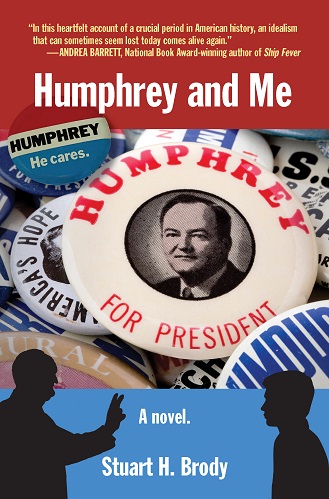Set against the backdrop of the tempestuous political eras of the 1960s and ‘70s, this novel features Ray Elias, a precocious but withdrawn 16-year-old growing up in an affluent suburb of New York. When Ray chances upon a documentary about Minnesota Senator Hubert Humphrey, Humphrey becomes his newfound hero. And to the amazement of Ray’s friends, Humphrey learns of Ray’s lobbying activities and takes Ray under his wing.
The relationship unravels when Humphrey becomes an ardent public supporter of the Vietnam War. Tension between them grows and their bond deteriorates, but as Ray matures to young adulthood, he reconnects with Humphrey—who achieves a political revival.
Loosely based on the author’s real-life relationship with Vice President Hubert Humphrey, Humphrey and Me portrays the often highly emotional journey that comes with embracing our heroes.
This is a slow-to-start novel, but anyone with curiosity about US politics of the 1960s and ’70s, or the desire for a good read on the ups and downs of adolescent hero-worship, will soon find themselves caught up in it.
It’s told mostly in the first-person point of view of Ray, who is 16 at the start of the novel, but has graduated from law school by the end (which actually makes calling it a young-adult novel questionable). But almost a quarter of the chapters are in the first-person point of view of Hubert Humphrey himself, an interesting approach.
I was a man who might, in a few short hours, become President-elect of the United States. They had to record the moment. So I was compelled to be the public man, in a moment when I wanted so very much to feel the sheer ordinariness of being a private man. Yet I was seeking the most public role in the world. I could not connect these two longings.
There’s plenty of material that illustrates why a young activist-in-the-making might look up to this perhaps under-appreciated historical figure, and it’s a treat as a reader to gain that perspective through the eyes of a teen. Here’s Ray in action as a young lobbyist:
I launched right in. “It’s the way he spots injustice and then tackles it head-on, as if there’s no way he could fail.”
“Go on,” Mr. Francis urged. “Tell us what you mean.”
“Well, I have a story that explains it. Before becoming a senator, Humphrey was mayor of Minneapolis. He ran on a platform of civil rights, an unusual thing in 1945. Well, one day, he paid a visit to Carl Dayton, head of Dayton’s Department Store, and said, ‘Now, Carl, I want you to start hiring Negroes. Set an example.’ Dayton didn’t want to do it, so Humphrey said, ‘Carl, I understand your position, but I’m advising you that if you don’t hire Negroes, we’re going to cancel all of Dayton’s contracts with the city.’ The result was that Dayton’s became the first department store in the country to hire Negroes. And Minneapolis became the first city in the country to pass an antidiscrimination ordinance.”
Mr. Francis nodded thoughtfully.
“Some might call what Humphrey did coercion,” I continued. “But what he was really saying was, ‘I’m not going to condemn you for the way you want the world to be. That’s up to you. But I’m determined to change the world because Negroes deserve a rightful place in it. And if I have to cancel the city’s contracts with you to do it, well, that’s what I’m going to do.’”
Lots of real-life characters drop in, including John F. Kennedy, Tom Hayden, Warren E. Burger, Eugene McCarthy, Robert Kennedy, Martin Luther King, Lyndon B. Johnson and Richard Daley. It feels like an insider’s tell-all of this complicated era, and will definitely expand young readers’ knowledge about the ’60s/’70s while whetting their appetite for more books on history and politics.
A complicated relationship between Ray and his overbearing father deepens our understanding of Ray’s challenges and personality, although too many chapters are spent on building that scenario, losing momentum in the process. Meanwhile, a romance between Ray and a fellow activist lightens things up and adds interest, although when they move in together in their twenties, once again it doesn’t feel like a young-adult novel.
The main weakness is that Ray, especially as the novel opens, is a rather unsure, spineless character, and we must slog through five chapters of his life before Hubert Humphrey appears and becomes his idol, at which point the plot definitely picks up. Had the book started with Ray discovering Humphrey, then back-flashed more briefly to Ray’s younger years, perhaps it would have avoided a slow start. But it’s definitely worth hanging in for those later chapters, and the book is hard to put down once Ray and Humphrey meet.
Overall, the writing is strong and the plot moves quickly. The era feels authentic, from what the characters eat to mention of TV tables and junk mail. The dialogue is crisp and realistic, and the characters have satisfying arcs. For a first young-adult novel, Humphrey and Me is impressive; the author has definitely written in a way that appeals to teens, on a topic sure to inspire.
-Pam Withers


